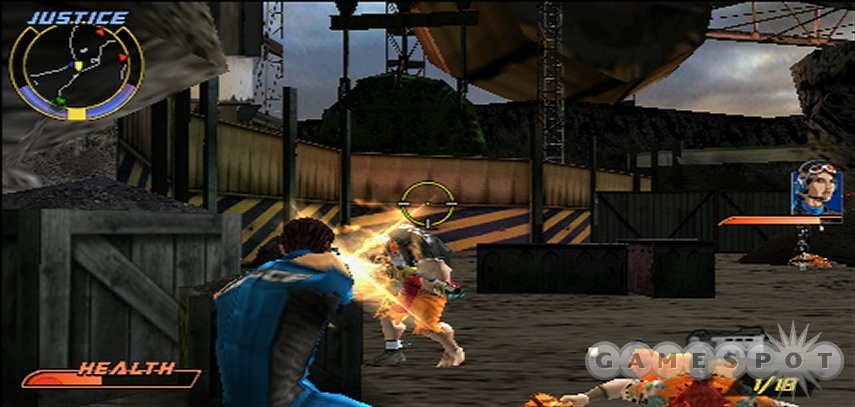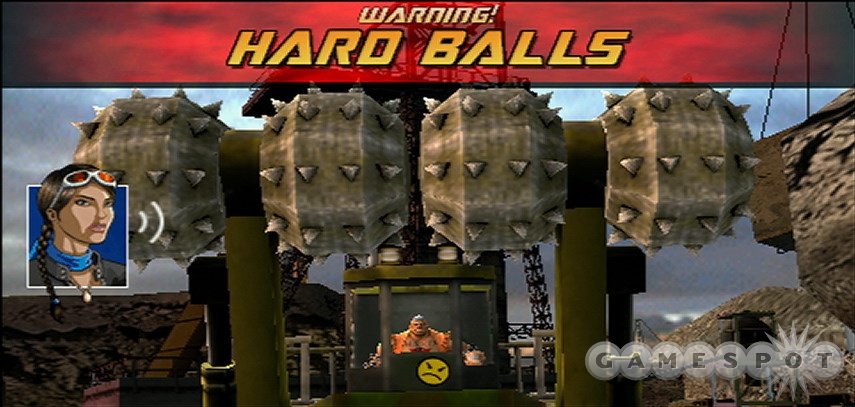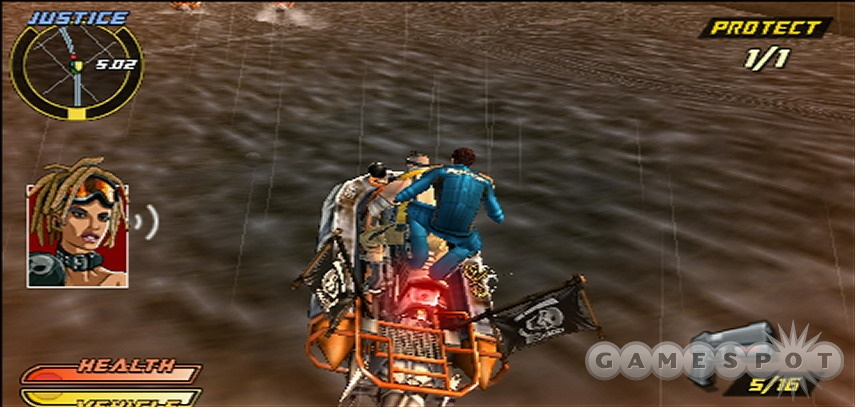When Pursuit Force was released in early 2006, it marked a great debut for newcomer Bigbig Studios. The game's innovative vehicle-to-vehicle jumping mechanic turned otherwise garden-variety high-speed car chases into action-packed sequences straight out of Hollywood. The game also offered variety courtesy of third-person shooter levels played on foot and rail-shooter levels in which you manned a helicopter gun. Two years later, in a sequel that's fittingly set just a couple of years after the events of the original, Pursuit Force is back. Pursuit Force: Extreme Justice doesn't mess with the original formula too much, but it adds a number of new features to the mix and, crucially, it isn't as frustratingly difficult as its predecessor.
In Pursuit Force: Extreme Justice, you reprise the role of the first game's protagonist, a rookie cop who has since been promoted to the rank of commander. The gang leaders you locked up last time have all escaped and, as you'll witness in the intro movie when they "crash" your wedding, they'll stop at nothing to get revenge. Furthermore, the Pursuit Force now has competition in the form of Viper Squad, another zero-tolerance law-enforcement unit that seems more interested in taking the credit for arrests than in actually making them. The story that plays out as you progress through the single-player game is every bit as Hollywood as the fast-paced gameplay, and though it's entertaining, it's also painfully predictable. Regardless, this isn't a game you're likely to be purchasing for its narrative; like so many movies before it, Pursuit Force: Extreme Justice is all about fast-paced, great-looking action sequences.

The single-player story mode spans some 30 missions, and the majority of those missions feature several distinct gameplay sequences. For example, a mission that gets underway with a car chase might also task you with sniping enemies from a helicopter, infiltrating an enemy base on foot, and then making your escape in a hovercraft. The most enjoyable sequences in Extreme Justice are those in which you're at the controls of a vehicle and, specifically, those in which you're encouraged to jump between vehicles in midchase simply by pulling up alongside them and hitting the O button. All of the vehicles--including motorcycles, trucks, hovercraft, speedboats, jet-skis, and plenty of different cars--handle differently, but they're all equally fun to drive. When taking control of an enemy's ride, you'll initially land on top of the vehicle and will have to shoot the occupants before you can climb inside, all the while using the dodge button to avoid their retaliatory attacks. Considering that the majority of your time in story mode will be spent in driving sequences, you might think that they'd start to feel repetitive, and you'd be right. However, your objectives are a little more varied than they were in the original game, and they might task you with driving either carefully or recklessly, for example, or with taking out enemies that are vulnerable only to certain methods of attack. There are also plenty of action sequences that don't involve you driving at all.
There are some variations on these themes, but for the most part Extreme Justice's rail-shooter sequences come in three distinct flavors: helicopter with a sniper rifle, helicopter's turret-mounted machine gun, and off-road vehicle's rear-mounted machine gun. The challenge in these levels is trying to line up your shots while compensating for the movement of the vehicle, which is especially difficult when you're trying to snipe enemies from a helicopter at the mercy of a pilot who flies like he'd spectacularly fail a breathalyzer test. Toward the end of the game, the rail-shooter sequences are some of the most challenging, but given that Extreme Justice's missions employ a new checkpoint system, at least you never have to play through other stuff over again to retry them.

By far the least-impressive sequences in Pursuit Force: Extreme Justice are those in which you go up against enemies on foot. The PSP's lack of a second analog stick really hurts here because, when you're running around, it's impossible to look or shoot in one direction while moving in another. In the absence of a lock-on feature like the one used in driving sequences, holding down the left shoulder button lets you zoom in on enemies so that you can aim more easily and, whenever possible, take them down with headshots. While you're aiming, your movement is limited to strafing left and right, so regardless of how you're playing, you never get the best of both worlds. The control limitations don't make Extreme Justice's third-person shooter sequences overly difficult, but that's only because few of the enemies have any interest in self-preservation. In fact, they're more likely to charge at you than to take cover, and if they get too close for comfort, you can put them in handcuffs simply by entering the correct combination of button presses as it appears on the screen.
The most memorable features of the story mode are, without a doubt, the boss battles against gang leaders and the like. These are invariably played out aboard large vehicles that, without spoiling anything for you, include a fire truck, a train, and an airplane, among others. After climbing aboard said vehicles, generally by way of a car chase or shooter sequence, you'll have to make your way to the boss by fighting through numerous gang members and avoiding environmental hazards. Although you're on foot, these levels work a lot better than the aforementioned third-person shooter sequences because you're rarely required to control your movement with the analog stick. Rather, after clearing all of the enemies from the area immediately ahead, you can advance to the next area with the push of a button. The bosses' attack patterns aren't too difficult to figure out and overcome, and your success will often depend on how efficiently you reached them rather than on how quick your reflexes are during the climactic battle.

Pursuit Force: Extreme Justice's story mode is a sizable offering, but there are still plenty of things for you to do once you've beaten it. There's a challenge mode in which you can revisit previously beaten action sequences and attempt to complete them with different objectives. The new bounty mode awards you stars for achieving certain scores while replaying entire missions. And then there are four different multiplayer games that support up to four players using an ad hoc connection.
Challenge mode is an interesting addition because it forces you to approach levels in different ways by giving you extra objectives and stripping away certain abilities. For example, there are challenges in which you're not allowed to jump between vehicles or use your justice meter (which charges up every time you take down an enemy) to replenish your health. There are even challenges in which your health is constantly draining or in which any collision while driving results in failure, so even the most skilled players are unlikely to breeze through them.
Replaying missions in bounty mode to achieve high scores would be a lot more interesting if there was some way to see your current score while playing. As it stands, you really have no idea what your score is until the mission is over and you're at the debriefing screen. The stars that you're awarded serve as currency at the Pursuit Force store, where you can spend them on cheat modes, artwork, and 3D models of characters and vehicles.
Like the different sequences in the single-player game, Extreme Justice's multiplayer offerings vary quite considerably in terms of quality. The rampage mode, in which up to four players on foot compete in a free-for-all deathmatch, is best avoided. On the other hand, the cops 'n' robbers mode plays out a lot like the single-player game's driving sequences (complete with jumping between vehicles) and is a lot of fun. The remaining two modes are survivor, which has one player driving an off-road vehicle while the other operates a rear-mounted machine gun and attempts to fend off large numbers of enemies, and ram jam, in which criminal players in bulletproof vehicles race to the finish line while cop players attempt to ram them off of the road. Unfortunately, each of the multiplayer modes can be played on only three different maps, and all suffer from noticeable (though not awful) lag, unless you're the player hosting the game.

Pursuit Force: Extreme Justice is a great-looking game with a solid frame rate that hiccups only during the most insane high-speed chases and in multiplayer games. Environments, vehicles, and characters are all nicely detailed, and the visuals hold up well even if you choose to play on a screen significantly larger than the PSP's. The Richard Jacques (Mass Effect, Jet Set Radio, Headhunter) soundtrack is also impressive and complements the onscreen action well. Less agreeable, unless you have a penchant for stereotyped accents from all over the world, is the voice acting. The four main gangs you're up against in the game consist of former Soviet mercenaries, London gangsters, rowdy rednecks, and Jamaican pirates, and they all sound exactly as you'd expect them to, or at least exactly what your uncle would sound like if you asked him to do an impression of them based on those descriptions. Some of the voices are amusing, some of them are a little grating, and all of them get irritating after you've heard them spout the same taunts and gags for the umpteenth time.
Pursuit Force: Extreme Justice is an easy game to recommend if you enjoyed its predecessor. It does everything that that game did a little bigger and little better. The game's three difficulty settings and new checkpoint system address the main complaint that anyone had with the original, and the storyline, though predictable, is entertaining enough and certainly never gets in the way of the action. If you're in the mood for a Hollywood blockbuster that you can play a starring role in, you could do a lot worse than to enlist with Pursuit Force.